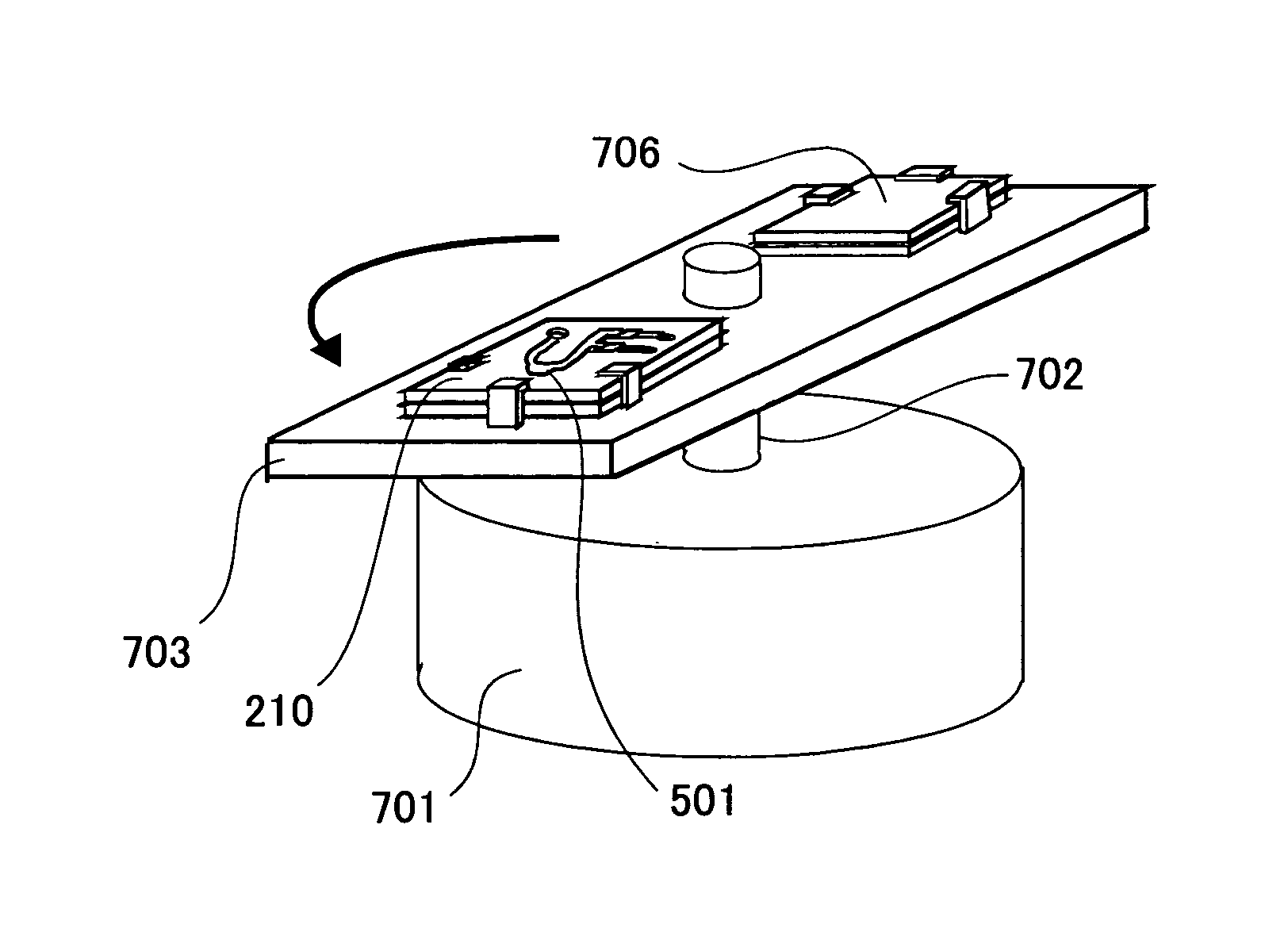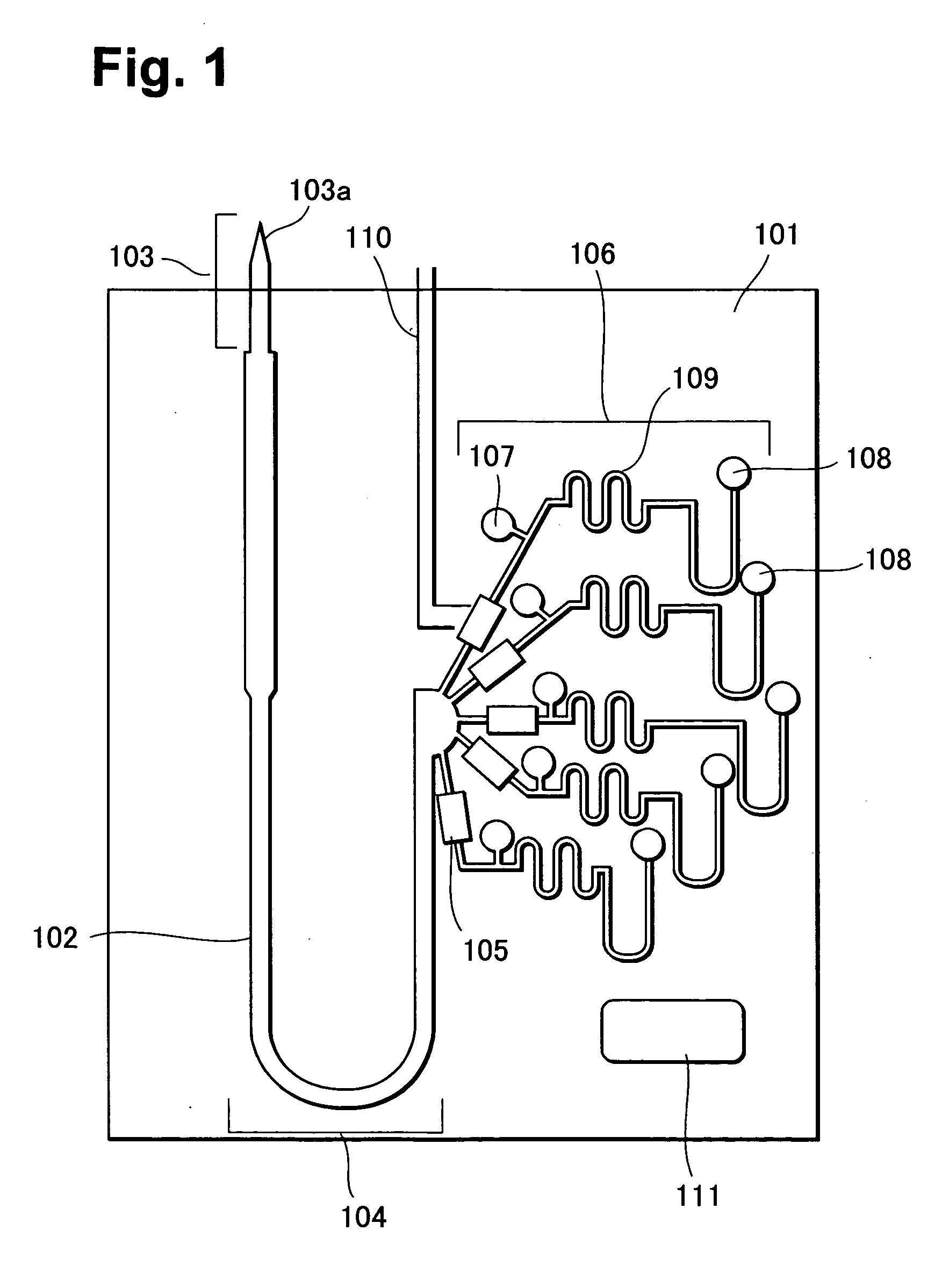Blood analyzer and method of separating plasma
a blood analyzer and plasma technology, applied in the field of chip-shaped blood analyzers, can solve the problems of unnecessarily increasing the amount of blood collected for clinical inspection, increasing the suction force or pump force, and unable to utilize the plasma on the upstream sid
- Summary
- Abstract
- Description
- Claims
- Application Information
AI Technical Summary
Benefits of technology
Problems solved by technology
Method used
Image
Examples
first example
[0052] A blood analysis apparatus shown in FIG. 5 was prepared, a blood sample was introduced into the blood analysis apparatus to perform centrifugation, and thereafter the plasma fraction was, sucked. Additionally, one analysis means was disposed in the blood analysis apparatus for simplicity (see FIG. 8). In the blood analysis apparatus, two polyethylene terephthalate (PET) substrates having a thickness of 0.5 mm were provided, and the flow channel 303 was formed in one substrate by molding. In the other substrate, a blood inlet port 302 and a blood draw-in port (outlet port) 801 were formed. And an electrode formed of carbon paste which was coated with a hydrogen ion sensitive film was prepared and disposed as analysis means 802. FIG. 8 schematically shows dimensions of a blood analysis apparatus 210 and the flow channel 303 formed on the apparatus. A depth of all the flow channel was 100 μm.
[0053] 1 μL of human whole blood was introduced into the blood analysis apparatus 210 t...
second example
[0059] A blood analysis apparatus 220 having a blood cell reservoir 501A was prepared as shown in FIG. 9(A). Blood was introduced into the blood analysis apparatus to perform centrifugation, and thereafter a plasma fraction 602 was drawn in. It is to be noted that dimensions of the blood analysis apparatus and a flow channel design in this Example are substantially similar to those shown in FIG. 8. As shown in FIG. (9B), this blood analysis apparatus is different from that of FIG. 8 in that an area of an interface between the separated plasma 602 and a blood cell fraction 603 is reduced as compared with a blood analysis apparatus shown in FIG. 8, when the blood is introduced onto the blood analysis apparatus to perform the centrifugation. Accordingly, a draw-in force applied to the blood cell fraction when sucking the plasma is reduced, the surface of the blood cell fraction can be prevented from being disturbed and mixed with the plasma, and substantially all plasma is securely mov...
third example
[0061] As shown in FIG. 10(A), a flow channel width of a lower part of a U-shaped flow channel 303 was increased to constitute a blood cell reservoir 501B, and accordingly a blood analysis apparatus 230 was prepared. In the same manner as in the first and second examples, attempts were made to introduce blood, separate plasma from the blood cell fraction, and draw in plasma fraction. By centrifugation after the blood introduction, as shown in FIG. 10(B), plasma 602 and blood cell fraction 603 were separated, and the plasma fraction 602 only was drawn in without disturbing the blood cell fraction 603, and could be fed into analysis means 802. From the present example, it is seen that it is especially important that the plasma fraction should continuously exist without being divided by the blood cell fraction, when the blood is separated into the plasma and blood cell fractions by centrifugation. This also applies to the blood analysis apparatus having the blood cell reservoir midway ...
PUM
 Login to View More
Login to View More Abstract
Description
Claims
Application Information
 Login to View More
Login to View More - R&D
- Intellectual Property
- Life Sciences
- Materials
- Tech Scout
- Unparalleled Data Quality
- Higher Quality Content
- 60% Fewer Hallucinations
Browse by: Latest US Patents, China's latest patents, Technical Efficacy Thesaurus, Application Domain, Technology Topic, Popular Technical Reports.
© 2025 PatSnap. All rights reserved.Legal|Privacy policy|Modern Slavery Act Transparency Statement|Sitemap|About US| Contact US: help@patsnap.com



